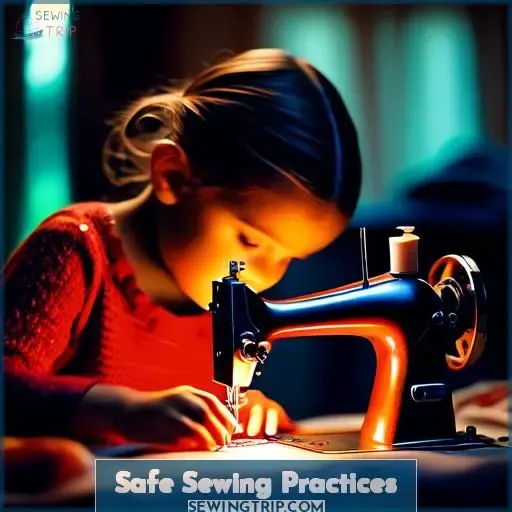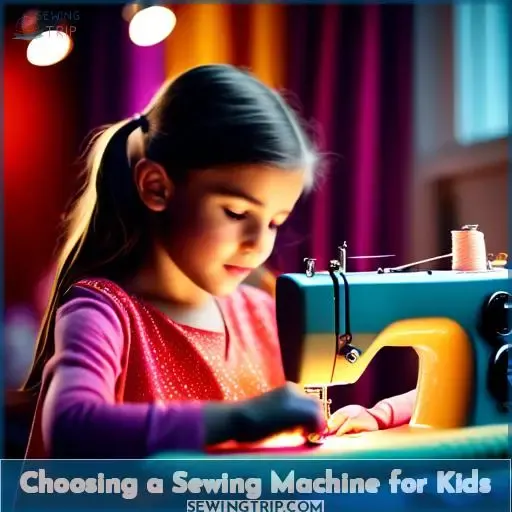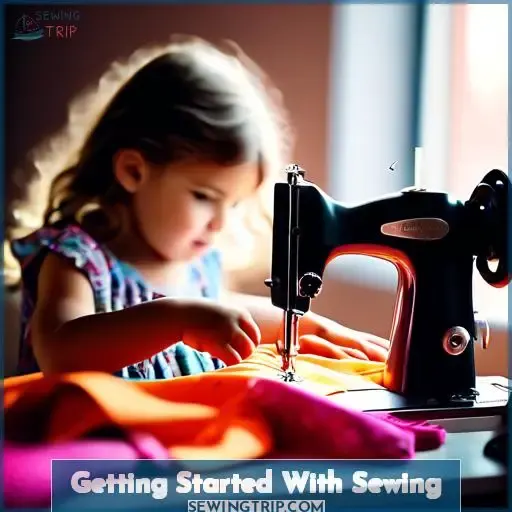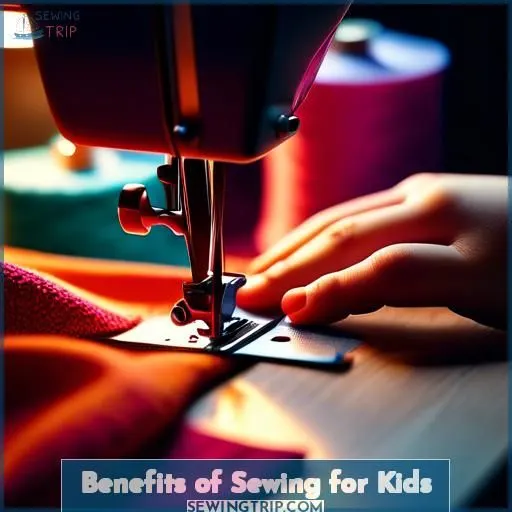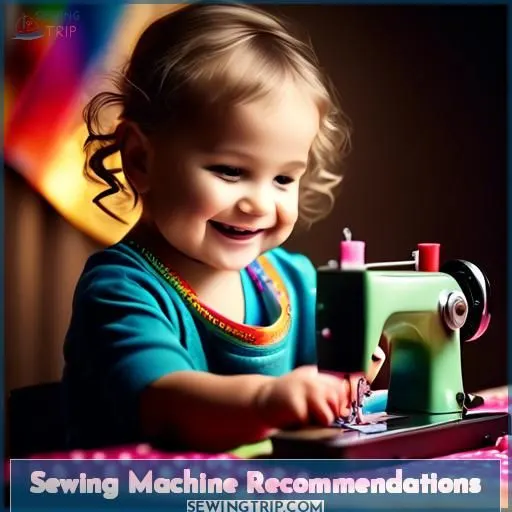This site is supported by our readers. We may earn a commission, at no cost to you, if you purchase through links.
You can safely introduce your child to simple machine sewing projects around age 6 with proper supervision and age-appropriate safety practices.
Start by teaching hand sewing at age 4 to develop fine motor skills.
Then, move to a child-friendly sewing machine with consistent speed control, push-button operation, and safety features like finger guards.
Prioritize safety by demonstrating proper needle threading, using scissors instead of rotary cutters, and marking dangerous areas on the machine.
With careful guidance and by following safe sewing practices, your child can explore their creativity while learning a rewarding new skill.
Mastering the basics now will pave the way for more complex projects down the line.
Table Of Contents
Key Takeaways
- Introduce children to hand sewing at age 4 to develop fine motor skills before moving on to machine sewing around age 6 with proper supervision and safety practices.
- Use child-friendly sewing machines that have consistent speed control, push-button operation, and safety features like finger guards to ensure a safe sewing experience for children.
- Foster creativity and patience in children by starting with simple sewing projects and gradually progressing to more complex ones as they grow older and their skills improve.
- Ensure a safe sewing environment by supervising children closely, using kid-friendly scissors, and teaching them safe needle threading and the importance of keeping their hands away from moving parts.
What Age Child Use Sewing Machine?
Children can start using a sewing machine from the age of four, but it requires full supervision due to their short attention span and the risk of injury. Most sewing experts recommend starting at the age of six, as children at this age can follow instructions better and need less supervision. By the age of eight, children can be left unsupervised with the necessary safety measures in place.
Age Appropriateness for Sewing
Choosing the appropriate age for a child to start using a sewing machine involves considering their skill level, safety, and supervision. Here’s a guide to help you determine the suitable age for your child:
- Age 4: Start with hand sewing to develop fine motor skills and basic sewing techniques.
- Age 6: Introduce them to a sewing machine with simple projects and guidance.
- Age 8: Allow for unsupervised sewing with more complex projects, but make sure they understand safety measures.
- Always consider individual learning pace and encourage creativity.
When it comes to safe sewing practices, follow these guidelines:
- Start with hand sewing before moving on to machine sewing.
- Use scissors instead of rotary cutters for safety.
- Clip instead of pinning, and keep pins secure with a pincushion and magnet.
- Ensure safe needle threading: use a pincushion for hand sewing, unplug the machine for machine sewing, and use an automatic needle threader.
- Mark dangerous areas on the machine, use finger guards, and wear safety glasses.
- Follow standard sewing safety tips.
When selecting a sewing machine for your child, consider these factors:
- Consistent speed control.
- Push-button machine preferred over foot pedal.
- Multiple speed settings.
- Lightweight.
- Variety of stitches (but not excessive).
- Fun design.
To get started with sewing, obtain sewing kits for kids, follow instructions, encourage creativity, and foster bonding experiences. Sewing can enhance reading, drawing, and creativity skills, develop fine motor skills, and foster patience and independence.
Safe Sewing Practices
Regarding safe sewing practices for children, it’s crucial to adhere to certain essential guidelines.
Always supervise children during sewing activities.
Begin with hand sewing before introducing them to a sewing machine.
Use kid-friendly scissors with blunt tips and encourage children to use clips instead of pins.
Keep pins secure with a pincushion and magnet.
Ensure safe needle threading by using a pincushion for hand sewing and unplugging the machine for machine sewing.
Mark potential hazards on the machine and use a finger guard, and have kids wear safety glasses.
Follow standard sewing safety tips, such as keeping hands away from moving parts, unplugging the machine after use, and using an automatic needle threader.
Choosing a Sewing Machine for Kids
Choosing the appropriate sewing machine is essential for guaranteeing your child’s safety and nurturing their love of sewing. Consider a machine with steady speed control, a button-activated operation instead of a foot pedal, various speed options, and a portable, compact design that includes a range of beginner-friendly stitches and a playful, child-appealing appearance.
Age-appropriate sewing machines
Regarding sewing with children, age-appropriate sewing machines are essential for a safe and enjoyable experience. Here are some guidelines for selecting a sewing machine for kids:
Consider their age: For children aged 4-6, begin with hand sewing to cultivate fine motor skills. Around age 6, introduce a sewing machine with basic stitches and speed control. By age 8, they might be prepared for more intricate projects with unsupervised sewing.
Safety precautions: Look for machines with safety features such as finger guards, speed control, and clear instructions. Keep needles and pins secure with a pincushion and magnet, and ensure safe needle threading with a pincushion for hand sewing and unplugging the machine for machine sewing.
Skill development: Start with basic stitches and gradually progress to more complex projects as their skills improve. Encourage creativity and bonding experiences.
Group lessons: For ages 8-10, group lessons can be suitable, with progress evident in seam allowance and pinning. For ages 10-12, kids can gain increased independence in sewing and handle more complex projects.
Curriculum: Consider using a curriculum like Kids Can Sew, which provides practice and instructions for all ages.
Machine recommendations: Consider machines like the Brother SM-2700, which is ideal for beginners due to its lightweight, user-friendly design, and comprehensive features. Stick with reputable brands like Singer, Husqvarna Viking, and Janome.
Essential supplies: Pre-cut quilting squares or charm packs, cotton fabric, and all-purpose sewing machine thread are recommended for beginners.
Helpful tools: Embroidery scissors, fabric rotary cutter, and cutting mat can assist in accurate cutting.
Getting started: Emphasize machine and needle safety, set the sewing speed to the slowest setting, and gradually assign responsibilities to the child. Commence with beginner-friendly projects like quilts and doll blankets.
Benefits: Sewing enhances creativity skills, develops fine motor skills, fosters patience and independence, and can be a fun and practical activity for kids.
Safe sewing practices
To guarantee safe sewing practices, commence with hand sewing before incorporating a sewing machine. Utilize scissors in lieu of rotary cutters, clips in lieu of pins, and secure pins with a pincushion and magnet. Instruct kids to thread needles safely and denote hazardous areas on machines. Foster creativity and patience while nurturing a bonding experience.
Choosing the right machine
Moving from secure sewing techniques, it’s essential to select the ideal machine for your budding tailor. Take into account age suggestions and machine features that prioritize safety measures. Here’s a quick checklist:
- Opt for ease of use with push-button starts.
- Make sure a stitch variety that’s appropriate—not overly complicated.
- Look for machines that make burlap and lacing cards projects effortless for children.
Getting Started With Sewing
Sewing is a delightful and rewarding activity for kids, but it’s crucial to start with the right tools and safety precautions. This guide will assist you in embarking on your sewing journey with your child, guaranteeing a safe and pleasurable experience.
- Choose the appropriate sewing machine: Seek a machine with consistent speed control, a push-button operation, and multiple speed settings. A lightweight machine is also advantageous for younger children. Reputable brands include Brother, Singer, Husqvarna Viking, and Janome.
- Safety first: Always keep an eye on your child when they’re using a sewing machine. Set the sewing speed to the slowest setting and gradually transfer responsibilities to them. Emphasize machine and needle safety, such as keeping hands away from the needle and using a finger guard.
- Beginner-friendly projects: Start with simple projects like quilts and doll blankets. These projects can help your child learn the basics of sewing without feeling overwhelmed. As they progress, introduce more complex projects like st■ animals or clothing items.
- Thread tension and fabric selection: Instruct your child on how to adjust thread tension and select appropriate fabrics for their projects. Cotton fabric is a good starting point for beginners, and pre-cut quilting squares or charm packs can simplify quilt projects.
- Sewing patterns: Use sewing patterns designed for kids to guide their projects. Peek-a-Boo Pattern Shop offers a wide variety of patterns suitable for different skill levels and styles.
- Essential supplies: Make sure your child has the necessary sewing supplies, such as pre-cut quilting squares or charm packs, cotton fabric, all-purpose sewing machine thread, and white thread for initial practice.
- Helpful tools: Encourage your child to use embroidery scissors for precise thread trimming, fabric rotary cutters and cutting mats for accurate cutting, and an automatic thread cutter for convenience.
Benefits of Sewing for Kids
Sewing offers a plethora of benefits for kids.
From enhancing their creativity skills by allowing them to design and bring their imaginative ideas to life.
To developing their fine motor skills through intricate hand-eye coordination required for stitching.
It also fosters patience and independence as they learn to methodically follow patterns.
And take ownership of their projects from start to finish.
Enhancing Creativity Skills
Immerse yourself in sewing and witness your imagination take control! It’s not merely about stitching fabric; it’s about narrating tales through sewing, where each thread weaves a tapestry of words.
Your artistic soul flourishes as you fashion personalized gifts that tell their own stories. Sewing isn’t merely a technical skill—it’s a canvas for your creativity, transforming simple projects into masterpieces of your own making.
Developing Fine Motor Skills
Developing fine motor skills is a vital part of a child’s growth, and sewing is an excellent activity to help achieve this. Here are four ways sewing can enhance fine motor skills:
- Lacing Cards: These are a great starting point for children as young as three. Lacing cards help children develop the fine motor skills needed for tasks like buttoning shirts or using scissors. They also foster patience and hand-eye coordination.
- Burlap Fabric: Sewing large buttons on burlap with a plastic needle and yarn is a fun and engaging activity for children. It requires precision and control, which in turn strengthens the small muscles in their hands and fingers.
- Embroidery Hoop: Using an embroidery hoop to secure burlap fabric is another way to introduce children to sewing. This activity helps them practice the coordination needed for more intricate sewing tasks.
- Sewing Machines: As children grow older, they can start using sewing machines. Sewing on a machine requires even more precision and control, further enhancing fine motor skills.
Fostering Patience and Independence
Sewing can be a great way to foster patience and independence in kids.
It’s like a therapy session, helping them develop social skills and cognitive growth.
As they work on their projects, they learn to problem-solve and build confidence.
It’s a fun and rewarding experience that can be shared with friends or family.
Just remember to start with simple projects and gradually increase the complexity as their skills improve.
Sewing Machine Recommendations
Choosing the appropriate sewing machine for kids is essential for their well-being and pleasure in the activity. Here are four essential elements to keep in mind when choosing a machine:
- Machine features: Look for fundamental features that align with children’s skill level. This includes a straightforward stitch selection, effortless threading, and a reduced sewing speed.
- Automatic needle threader: A machine with an automatic needle threader can simplify the process for children to learn how to thread the needle independently.
- Thread cutter: A thread cutter can assist children in managing the thread more effectively and avoiding tangles.
- Respected brands: Choose well-known brands renowned for producing dependable and safe sewing machines. Brother, Singer, Husqvarna Viking, and Janome are some recommended brands.
When selecting a sewing machine for your child, remember to prioritize safety and features that are suited to their age.
Frequently Asked Questions (FAQs)
At what age is it safe for a child to use a sewing machine unsupervised?
You’ll want to wait until around age 8 before letting your child sew unsupervised. Kids this age can handle a machine safely with some guidance first. Work together initially, and watch for good habits forming before giving them that freedom.
What are the recommended safety precautions for children using a sewing machine?
As the old saying goes, safety first! Never leave a child unsupervised with the machine. Unplug it when not in use, use finger guards, and model proper techniques – slow and steady wins the sewing race.
How can parents ensure that their child’s workspace is safe for sewing?
Set up a dedicated sewing area with good lighting and clear surfaces. Keep scissors, pins, and machine parts organized and out of reach from little hands when not in use. Supervise closely, especially with younger sewists, to prevent accidents and promote safe habits.
What are the benefits of teaching children to sew at a young age?
Sewing sparks creativity and boosts dexterity from an early age. You’d be amazed at how quickly kids grasp new skills – threading needles, tracing patterns. Plus, the sense of pride in crafting something tangible is priceless! With proper guidance, sewing fosters focus and resilience too.
What are the best sewing machines for children, and what features should parents look for when choosing one?
You’ll want a beginner-friendly machine with consistent speed control. Look for push-button operation, multiple speed settings, and fun designs to keep kids engaged. The Brother SM-2700 is a great starter option – lightweight, user-friendly, and reasonably priced.
Conclusion
By thoughtfully introducing your child to the sewing machine at an appropriate age, you’ll open up a realm of creativity that will amaze you!
Adhere to safe practices, select an appropriate child-friendly machine, and guide them with patience.
Acquiring the knowledge of the suitable age for a child to safely use a sewing machine will cultivate valuable abilities.
It will also embark them on a journey of enduring creative expression through this fulfilling craft.



